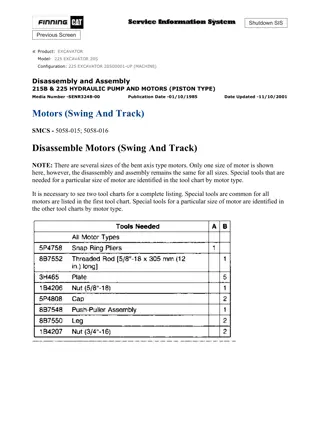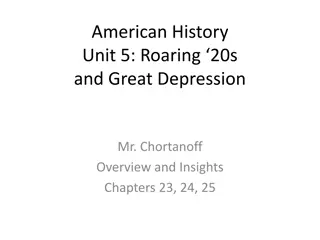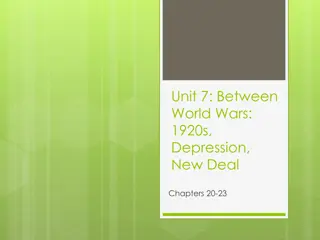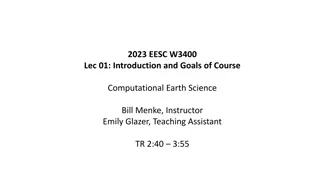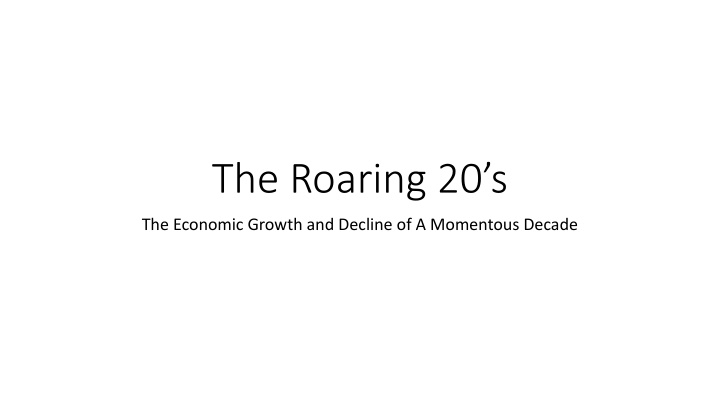
Economic Growth and Decline in the Roaring 20s Decade
Explore the economic fluctuations of the 1920s, from the V-shaped recession of 1920-1921 to the subsequent economic boom marked by increased standards of living, industrial growth, and societal shifts. Learn about the factors contributing to both positive and negative trends during this momentous decade.
Download Presentation

Please find below an Image/Link to download the presentation.
The content on the website is provided AS IS for your information and personal use only. It may not be sold, licensed, or shared on other websites without obtaining consent from the author. If you encounter any issues during the download, it is possible that the publisher has removed the file from their server.
You are allowed to download the files provided on this website for personal or commercial use, subject to the condition that they are used lawfully. All files are the property of their respective owners.
The content on the website is provided AS IS for your information and personal use only. It may not be sold, licensed, or shared on other websites without obtaining consent from the author.
E N D
Presentation Transcript
The Roaring 20s The Economic Growth and Decline of A Momentous Decade
1920-1921 Recession Most associate the decade of the 1920 s with continuous economic growth. However, this growth was preceded by the 1920-1921 V-shaped recession lasting from January 1920-July 1921. Contributing to this downturn was the decline in exports. The total value of all exports fell by over 32% between 1920 and 1921. This was most evident in the agricultural sector, as the surplus farm commodities that were bought up by European nations during and immediately after World War I, were now competing against increased European agricultural output levels. The result was declining prices, due to a higher overall supply, thereby leading to a steady decline of U.S. agricultural exports from earlier periods. Besides the effect on the agricultural sector and consequently exports, the following economic occurrences were experienced during this recession: GNP fell by 24% between 1920 and 1921. Prices for all commodities fell by 34% between 1920 and 1921, with prices for agricultural goods decreasing by 38% and prices for manufactured goods declining by 30%. Industrial production fell by more than 23% between 1920 and 1921. The number of business bankruptcies rose 40% between 1920 and 1921, and in fact grew another 40% between 1921 and 1922. Unemployment, which had been at a post World War I low of 1.4% in 1919 climbed to 5.2% in 1920 and 11.7% in 1921.
Economic Growth during the 1920s The decade witnessed an increased standard of living as seen in the statistics below: Real GNP increased 59%; Real GNP per capita increased 42% Personal income increased 38.3%; real income per capita rose 2% per year. However, this was not equally distributed across all classes of society. The share of income going to the top 1% rose from 13.1% in 1923 to between 18.4% and 18.9% in 1929, while the income for the top 5% over the same period rose from 27.1% to 33.5%. Output per worker hour increased 26.6% Manufacturing productivity increased 91.7% Stable price level Factors contributing to the increased standard of living Mass production became more commonplace and contributed to mass consumption, contributing to the increased need for advertising and other marketing activities. Advancements in the production of consumer durables (goods lasting more than three years, like automobiles and many home appliances). This led to increased consumption of such goods. The ability to pay on credit allowed more households to purchase items they could not immediately afford. Increased array of goods Electric power Suburban housing City skyscrapers
Positive Growth during the 1920s At this time, the U.S. became the largest creditor nation Despite increased exports (33%) being outweighed by increased imports (41%), the nation still maintained a trade surplus. The overall population increased by 15.7% during the decade, much of it seen in the cities. Much of this increase was due to increased living standards, medical advancements, and decreased infant mortality rates. The labor force grew at a faster rate of 17%. There was a shift away from agriculture to manufacturing and more so to services. Of the three sectors, agricultural wages were the lowest, meaning that average wages rose. Growth of numerous industries, especially the automobile along with chemicals, communications and construction. A major economic fact of life during this period was the extent to which scientific discoveries, inventions and innovations, and new manufacturing methods created in one industry led to successive repercussions in other industries. What contributed to the overall GNP growth, which trended upwards over the decade were increased household consumption and business investment, as evidenced by the table on the next page.
Automobiles Central to the growth of the 1920s was the automobile industry. Initially considered a luxury that only the wealthy could afford, the 1920s saw the automobile evolve into a convenient, low-cost form of personal transportation for many. This was due in large part to the mass production techniques, mainly the assembly line employed by Henry Ford, that were improved upon during the course of the 1920 s. This was most evident in the 7.4% average decline per year in the number of labor hours needed to construct a car. Annual sales of passenger cars more than doubled between 1920 and 1929 (from 1.9 million to 4.5 million), while automobile registrations almost tripled during this same timespan (from 8.1 million to 23.1 million). Annual production rose from 1.5 million cars in 1921 to 4.8 million in 1929. By the end of the decade, nearly 60% of all American households owned a car. The growing popularity of cars also led to increased demand for specific resources that spurred growth in the petroleum, steel, rubber, and glass industries. It also provided a boost to the insurance industry. The automobile facilitated the movement of more people and economic activities to the suburbs of the nation s large cities. This contributed to investments in residential, commercial, and industrial construction. The automobile also brought new possibilities for tourism and travel and helped create roadside facilities, like motels and gas stations, for travelers. The success of the automobile also spread across borders, as by 1929, cars represented 10% of all American exports.
Unsuccessful Industries Despite the successes experienced in numerous industries, there were industries that did not share in this success due to stagnating markets and intensifying competition. Within said industries, firms relied on minor innovations, improvements in existing technologies, and some rationalization of operations that contributed to a shrinkage of the work force. Three of the largest industries that experienced this decline were railroads, coal mining, and textile manufacturing.
Agriculture Besides the sectors listed on the previous slide that did not revel in the success of the 1920s, agriculture also did not share proportionately in this upward trend. This was due to the fact that demand was not able to match the increasing supply, resulting from increased technological advancements such as enhanced tractors. In other words, the increased American income was not being used to buy more food but was instead being used to buy more durable goods. Part of the increased supply arose from Europe, where with the end of World War I, agricultural production was able to resume, meaning European nations were no longer reliant upon the United States to supply these essential items. As such, the prices received by farmers declined by almost 40% between 1919 and 1921, alone. Due to the loss of incomes for many farmers, during the mid-1920s, there were a number of foreclosures on farm properties. As domestic consumption rose, income in the agricultural sector did begin to recover by the mid- 1920s and stayed level from 1925 to 1929. In addition, some government assistance programs were initiated to aide farmers, with varying degrees of success.
Labor The unemployment rate is estimated as being at 5.1% between 1923 and 1929. More specifically, unemployment was at its peak of 11.7% in 1921 and dropped to 3.2% in 1929, although it was not a steady decline over the period. The decline in unemployment led to increased prosperity and consequently increased spending. Average real annual earnings rose 23% between 1919 and 1929 with skilled workers earning 30% more than unskilled workers. These increased earnings can be explained by the faster rate of growth of white-collar workers compared to manual and service workers. Many of these new, white-collar positions required a higher level of educational attainment than did manual labor, and they were rewarded with higher compensation. In 1920, 16.3% of 17-year-olds graduated from high school. By 1930, this percentage increased to 28.8%. There were also gains in female employment at this time, especially within the white- collar sectors. Women accounted for 22.1% of the labor force by the end of the 1920 s compared to representing 20.5% at the start of the decade.
Fiscal Policy All in all, the presidential administrations of the decade, as seen by the enacted policies, such as tax cuts (especially for the wealthy) and protective tariffs revealed them to be pro-business. The goal of fiscal policy was to reduce taxes, and as a result, reduce government involvement in the economy in order to aide the business sector. This was seen with the Revenue Act of 1921, Revenue Act of 1924, and Revenue Act of 1926, shifting the tax burden away from high-income and wealthy groups. This was a precursor to the concepts of trickle- down and supply-side economics of later decades. During the decade, very few new spending programs were introduced by the federal government, and its overall total spending remained relatively stable. Consequently, the federal budget showed a surplus in every year of the decade.
Monetary Policy Federal Reserve During the recessions that occurred during the decade, the Federal Reserve lowered interest rates to encourage spending and also purchased government bonds. In February 1925, they began raising rates, doing so from 3.0% to 3.5% and later that year to 4.0%. However, when the stock market began to decline in 1926, the rate was lowered back down to 3.5%. This showed to many that stock market activity, not the domestic economy, drove monetary policy during the growth years between the recessions. As things became more settled, the Federal Reserve once again raised the discount rate back to 4.0% in the summer of 1926. However, with the 1926-1927 recession (to be discussed on the next slide), the Federal Reserve decided in the summer of 1927 to lower the discount rate to 3.5% and purchase more government bonds. Concern was not with bank closures, but with Wall Street speculation instead. Thus, their actions in 1927 helped contribute to the already increasing speculation occurring in stocks. On August 9, 1929, the Federal Reserve increased the discount rate from 4.5% to 5.5%. Their actions during the recessions of the 1920s along with the build-up to the events of October 1929 revealed their inability to foresee the possibility of a much greater economic downturn or depression. The decade also witnessed a number of bank failures, adding up into the hundreds each year, with a peak of 975 bank failures in 1926, alone.
Mid-Decade Recessions Although the period is known for its significant economic growth, there were in fact two recessions during the middle part of the decade in addition to the one that occurred at the start of the decade. The first one lasted from May 1923 through June 1924, and the second one lasted from October 1926 through November 1927. Part of what contributed to the decline in the latter recession, as seen on the table in the fifth slide, was the decreased rate of consumption growth from 1926 through 1928. This can be attributed to the decline of consumer durables purchases. At this time, the automobile was no longer a novelty, and the market for new buyers was diminishing. Similarly with investment spending, residential construction was important during the first half of the decade, peaking in 1926, as per the table, and then steadily declining through the end of the decade. This decline was due to the supply catching up with the demand for those who could afford to purchase a home. The reason gross investment rose after 1928 is because of increased expenditures on business plants and machinery.
1920s Speculation The decade of the 1920s also experienced quite a bit of speculative froth. In Italy, Charles Ponzi promised his investors high rates of return, 50% in 45 days, through the purchase of international postage stamps, which would be bought in Italian lira and sold in American dollars. This did not come to fruition and has led to the moniker Ponzi Scheme. There was speculative interest in the market for land during the middle of the decade nationwide, with the primary focus being on Florida land. During the spring and summer of 1926, the real estate bubble began to deflate. The winter tourist season had been disappointing, and the signs of overbuilding were apparent everywhere. In September 1926, a hurricane devastated Miami, the heart of the boom, wrecking construction sites and possibly the belief in the idyllic life in Florida, and thereby putting an end to the Florida Land Boom. Before the boom collapsed, thousands of small investors had squandered their savings on unimproved tracts of land, some of which were even underwater, in the hope that a greater fool would pay more than they had. Despite their efforts, the banking system was not able to recover from the numerous loans made to build up the housing sector before the onset of the Great Depression. The most significant speculation though occurred on Wall Street, as will be explained two slides forward.
1928 Economic Situation The unemployment rate rose to 4.2%, which was higher than its peak during the 1926-1927 recession, when it topped out at 3.3%. Meanwhile, prices and real GNP remained relatively stable. Despite this economic stagnation, the stock market became bullish in the spring. On a weekly basis, the stock market trended upward, with more people entering the market, hoping to get rich quick. As stated before, the Federal Reserve closely watched the level of activity on the stock market and reacted by raising the discount rate to 4% in February 1928, followed by an increase to 4.5% in May, then to 5% in July, and 6% in August. These higher interest rates attracted more funds into the stock market via financial intermediaries, corporations, and foreign investors. With increased speculation occurring within the stock market, the Federal Reserve took no action with regards to changing interest rates or purchasing government bonds between August 1928 and July 1929.
Stock Market Activity and Speculation 1922 1929: stock prices more than tripled 1928 1929: average stock rose 26.5% in value 1929 stock prices were 2.5 times what they had been in 1925 March 1928: beginning of the bubble In the summer of 1929, stock prices began to surge once again, after having been in an up-and- down pattern since the start of the year. Observing these higher prices and hearing of so many success stories, either directly or indirectly, many more individuals wanted in on the stock market success. Despite concerns of risk involved in participating in such activity, many small and large investors were willing to take their chances. During the fall of 1929, the break in the stock market surge saw several weeks of alternating panic followed by anemic recovery of stock prices. Throughout September 1929, prices trended downward. What fueled much of the rise in stock prices? One explanation was the increased earnings of, and dividends paid by, corporations during the 1920s. A second cause was the significant increase in credit made available in the form of brokers loans. Traders need only put up 10%-20% of the purchase price and use the securities as collateral for the loans. Despite the Federal Reserve s actions of raising the discount rate beginning in 1928, many speculators were not discouraged , as they believed they could use borrowed money to make a profit in the stock market.
October 1929 October 1929, particularly October 23 October 29 10/24: Black Thursday 13 million shares were traded. This was more than 4 times larger than the normal 3 million shares traded daily. 10/25: Banks and investment houses organized buying. This action prevented a complete rout. 10/28: Black Monday - 3 million shares were traded in the last hour. The overall stock market value fell by $14 billion. 10/29: Black Tuesday The slide in the Stock Market continued until mid-November. At this time, stock prices had fallen to about half of the value they achieved back in August 1929.
Conclusions The boom of the 1920s allowed society to realize the gains that could be achieved. However, the downturns, especially in 1929, reminded society of the losses that threaten to reverse the successes. The negative impact of the stock market decline in late 1929 served to lessen the confidence of businesspeople, consumers, and investors, which had ripple effects throughout the economy and the nation, as a whole, and likely exacerbated the severity of the downturn. There is no one cause or entity to blame for the decline seen at the end of the 1920 s, particularly in the stock market. Does the blame lie with the Federal Reserve, which some economists argue did not do enough to curtail the easy money that contributed to the speculation in both the real estate and stock markets? Does the blame lie with the federal government for lowering taxes that may have contributed to the growing income inequality that led to more stock market activity? Does it lie elsewhere? Was the decline inevitable, after witnessing the speculation in the real estate market earlier in the decade? That is what makes economics so interesting, there is not always a clearly defined answer. Hopefully, after reading through these slides, you can draw your own conclusions.


